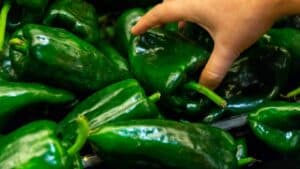Have you noticed worrisome black spots marring the leaves of your prized pepper plants? As a fellow gardener and pepper enthusiast, I completely understand how distressing it can be to see your plants struggling with this discoloration. Blackening leaves are never a welcome sight!
The good news is that it’s usually possible to get to the root of the issue and restore your plants to their former healthy glory. Through some detective work, we can likely figure out what factors are causing the problem.
There are a few common culprits that can result in pepper plant leaves turning black:
- Improper watering – both overwatering and underwatering pepper plants can actually lead to blackened, dying leaves! It’s essential to maintain an even moisture balance in the soil.
- Lack of important nutrients like nitrogen, magnesium and calcium. These deficiencies interrupt plant processes, leading to black blotches.
- Disease issues such as fungal anthracnose or bacterial leaf spot also leave dark lesions on leaves.
- Sunscald from intense sun exposure can literally burn leaves black.
- Sensitivity to cold temperatures may blacken or wilt the foliage.
Identifying the specific cause is crucial so that you can take targeted action to remedy the problem. For instance, adjusting your watering schedule, applying fertilizer, using preventative fungicides, providing shade cloth, or protecting plants from frost.
While it may take some diligent troubleshooting and tender loving care, most causes of black leaf spots can be corrected with a little knowledge and effort. I’ve compiled all the essential information you need to bring your peppers back to their peak growing condition.
Throughout this article, we’ll explore these common causes of black pepper leaves in greater detail. I’ll provide tips and solutions tailored to each situation, so you can get your plants healthy and flourishing once again. Let’s get growing!
Can You Revive Pepper Plant Leaves That Turn Black?
First off, seeing those unsightly black spots and shrivelled, dying leaves on your precious pepper plants is disheartening. You’ve put time and care into growing your peppers, so you don’t want to lose them to issues like diseases, under-watering or nutrient deficiencies.
The good news is that with prompt treatment, you can often revive pepper plants and restore their leaves to a healthy dark green. But how do you bring your plants back from the brink once the leaves start to blacken?
Act quickly at the first signs of trouble. The sooner you can diagnose and correct the problem, the better chance your plants have of bouncing back. Leaves that have already turned black likely won’t recover, but new growth should return to normal.
Fix any watering issues. Adjust your watering frequency and volume to keep soil consistently moist but not saturated. Proper moisture is key for transporting nutrients to leaves and maintaining vigorous plants.
Treat nutrient deficiencies. Apply balanced fertilizer or nutrient amendments like compost or manure to nourish your plants. Lack of nitrogen is a common cause of foliage issues.
Control diseases. Remove damaged leaves to prevent disease spread. Apply fungicides or bactericides as both treatments and prevention against pathogens.
Provide shade from intense sun. Add shade cloths, awnings or shade trees nearby to protect delicate leaves from sunscald damage.
Protect against temperature extremes. Cover or move plants to shelter them from frost. Ensure they receive sufficient warmth, especially at night.
Overwatering and Underwatering Can Cause Black Leaves
One of the most common reasons for black pepper leaves is improper watering. Both overwatering and underwatering your pepper plants can result in blackening leaves.
If you’re overwatering, the excess moisture prevents the roots from getting the oxygen they require. This leads to root rot, which blocks the roots’ ability to take up water and nutrients. As the roots die, they are unable to transport water to the leaves which then dry out and turn black.
Underwatering can also cause the leaves to dry out, shrivel up and turn black due to lack of moisture. Check the soil moisture regularly by sticking your finger into the soil. It should be moist but not soggy. If the soil is dry an inch below the surface, it’s time to water.
Adjust your watering schedule to allow the soil to partially dry out between waterings. This gives the roots a chance to breathe while still getting moisture. Proper watering is key for healthy pepper plants.
Nutrient Deficiencies Can Cause Black Pepper Leaves
Black leaves on your pepper plants may indicate a nutrient deficiency. Pepper plants need a regular supply of essential nutrients like nitrogen, calcium and magnesium for optimal growth.
Nitrogen is particularly important, as it facilitates leaf growth and gives leaves their healthy green color. Without enough nitrogen, the older leaves may turn yellowish or black and fall off.
Calcium and magnesium are also important for leaf development. Lack of these secondary nutrients leads to black blotches on pepper leaves.
If you suspect a nutrient deficiency, fertilize your plants with a balanced soluble fertilizer or work some compost into the soil. This will provide a boost of nitrogen, phosphorus, potassium and micronutrients.
Best Fertilizers For Black Pepper Leaves
If nutrient deficiencies are causing those unsightly black spots on pepper leaves, a fertilizer boost can help strengthen your plants. Certain fertilizers are ideal for nourishing peppers and restoring damaged foliage.
Nitrogen-rich fertilizers – Since nitrogen deficiency frequently causes leaf issues, choose a fertilizer higher in nitrogen to spur lush, healthy growth. Look for the first number on the NPK ratio to be higher.
Balanced soluble fertilizer – Apply a complete liquid plant food with equal proportions of nitrogen, phosphorus and potassium. This provides overall nutrition.
Compost or manure – These add a variety of macro and micronutrients. Work them into the soil prior to planting.
Calcium-magnesium supplement – Blend this into soil if low calcium/magnesium is suspected. Or spray leaves.
Kelp or seaweed extract – These provide vitamins, minerals and growth promoters to stimulate plants.
Fish emulsion – An organic source of nitrogen and other nutrients to nurture plants.
Chelated iron – Iron deficiency can also cause leaf blackening. Use iron chelate spray.
By using the right fertilizer for your needs, you can nourish plants, prevent future issues, and get those pepper leaves back to a vibrant dark green. Targeted feeding is a key step in revitalizing damaged foliage.
Fungal and Bacterial Diseases Cause Black Spots
One of the most detrimental causes of black leaves on peppers is fungal or bacterial diseases. Several plant pathogens lead to dark spots and lesions on leaves and stems.
Anthracnose, caused by the fungus Colletotrichum, results in dark, sunken spots on leaves and fruits. Bacterial leaf spot, caused by Xanthomonas campestris pv. vesicatoria, also leads to black water-soaked spots.
To control fungal and bacterial diseases on your peppers:
- Remove any infected plant material and throw it away to prevent spreading.
- Improve air circulation around plants to reduce humidity.
- Avoid overhead watering which spreads pathogens.
- Apply copper fungicide sprays as a preventative treatment.
- Rotate crops each year to prevent disease carryover in the soil.
Sunscald Can Cause Black, Dry Pepper Leaves
If your pepper plants experience a rapid transition from shade to intense sun, the leaves may develop black patches from sunscald damage. The leaves literally get burned by the sun’s UV rays.
To prevent sunscald:
- Gradually acclimate young plants to increased sunlight levels over 7-10 days.
- Provide shade cloth over new transplants while they establish.
- Plant in an area with some shade during the hottest parts of the day.
- Paint or spray white wash on plastic pots to reflect heat away.
Cold Temperatures Can Cause Blackening
Cold intolerance can also lead to blackening and wilting of pepper leaves. Peppers thrive in warm weather between 70-90°F and don’t tolerate frost or cold winds at all.
If cold weather is in the forecast, take preventative measures:
- Cover plants with frost cloth or plastic sheeting overnight.
- Move potted pepper plants indoors or under a covered area.
- Avoid planting peppers too early in spring when frost is still a risk.
- Provide a heat source like a cloche or cold frame over young plants.
With some troubleshooting and plant care adjustments, you can get those pepper plants thriving again! Identify the culprit causing the black leaves, then take action to remedy the situation. With a little TLC your peppers will be back to their beautiful leafy green selves.
Do Black Pepper Plant Leaves Decrease Pepper Production?
If you’ve noticed dark blemishes and spotting on your pepper plant leaves, you may be worried about the impacts on your yield. Can black leaves actually decrease the number and quality of peppers your plants produce?
Unfortunately, the answer is generally yes. Here’s why pepper plants with black leaves often produce less fruit:
- Leaf issues impair photosynthesis, reducing energy for fruiting.
- Nutrient deficiencies that cause black leaves also deprive fruits.
- Diseases infecting leaves spread to stunt and damage fruit.
- Loss of leaves means less foliage to support peppers.
- Stress from improper moisture, light, or temperature disrupts flowering.
Essentially, unhealthy leaves compromise the plant’s ability to direct energy and resources toward developing peppers. Plus, factors that damage leaves like diseases, poor soil nutrition, and environmental stresses also take a toll on fruits.
The good news is that by troubleshooting and fixing the underlying cause of black leaves, you can get your plants back to peak production capacity. Proper care and growing conditions will minimize leaf problems and ensure your peppers thrive.
Signs You Should Give Up On Reviving a Pepper Plant
Sometimes pepper plants become so stressed, diseased or damaged that revival becomes unlikely or impossible. As discouraging as it is, there comes a point when you may need to pull up unsalvageable plants and start fresh. But how do you know when to call it quits?
Here are signs a pepper plant is too far gone:
- The entire plant is wilted, droopy or collapsed.
- Most leaves have shriveled or dropped off.
- Main stems and branches are very brittle or mushy.
- Roots are brown, rotten smelling ornonexistent.
- Plant pulls up easily from the ground without resistance.
- No new leaf growth after 2-3 weeks of remedial care.
- Rampant disease has overtaken most of the plant.
- Severe insect infestation covers the remaining foliage.
- Plant is struggling to stay upright, falling over.
If your pepper plant exhibits several of these symptoms, recovery is unfortunately unlikely. At that point, the wiser option is to remove and discard the plant to prevent further spread of disease to healthy plants nearby.
Starting over with a new seedling gives you the best chance of success. Focus your efforts on growing strong, vigorous plants right from the beginning. With careful cultivation, your new peppers will flourish!






